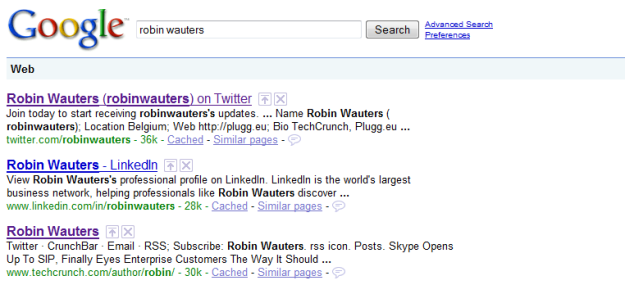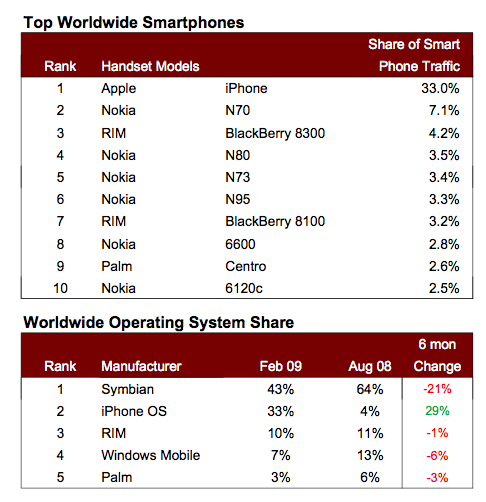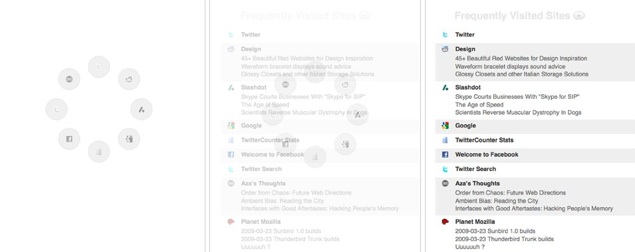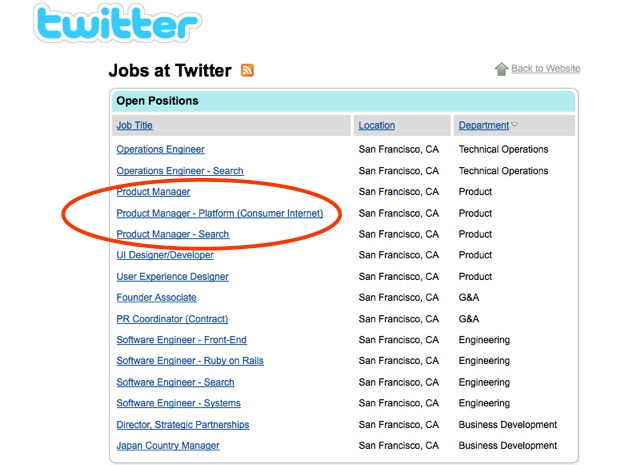The Latest from TechCrunch |  |
| Twitter Tweaks Its Title Tags For Better Google Juice Posted: 24 Mar 2009 08:25 AM PDT
Notice that title tag for my Twitter profile page? It reads “Robin Wauters (robinwauters) on Twitter” where it used to say “Twitter / robinwauters”. For the TechCrunch Twitter account, it used to read “Twitter / TechCrunch” (only the username) instead of now “Michael Arrington (TechCrunch) on Twitter” (full name + username). Minor tweak, you say? Mundane change? Perhaps, but with an undeniably big impact on how high Twitter pages will be ranked in search engines from now on. Still skeptical? Do a Google search for your name, or try mine. For the longest time, my LinkedIn profile and now defunct blog about internet marketing used to show up as the first results, battling with other social networking profiles and websites. Today, it shows my public Twitter profile page as the number one result. The first thing anyone will click on when they do a search on my name. That’s huge.
I tested a few users who’ve had a public profile for more than two years, and the results are telling: nearly all of them have their Twitter profile linked in the top 5 results when performing a Google search. Try it out yourself to see how high yours is ranked. We’re not sure when exactly Twitter tweaked the way it presents title tags, but when searching Google the old representation can currently still be found in the search results (i.e. you can still see Twitter / TechCrunch when you do a search for “Michael Arrington”), so we’re assuming this is shiny new. Update: changes were made yesterday according to co-founder Biz Stone. The implications are not to be underestimated. Being the top result for a name search means business, just ask all those venture-backed startups building people search engines who are vying for the sweet spots on the first page. Consider the fact that Facebook is changing its profile URLs to better carry a person’s name for their profiles. Think about simple services like MeeID or UnHub who were on their way up the search results for full names of people who registered their personal profiles there. For most users with a public stream, Twitter is trumping them. If Twitter can dominate the number one spot for queries on people who have a public profile on the social micro-sharing service, that is one more entry point into Twitter which should help it continue to grow visitor traffic exponentially. Furthermore, more new users might be enticed to sign up to try out the service themselves because their friends or relatives are apparently using it too. Conveniently, this is all popping up at a time when the startup’s business model is becoming more and more apparent, its momentum is going through the roof and much larger companies are turning their heads to see what all that noise is about. Anyone still think Twitter is peaking, or even headed for the deadpool? Crunch Network: CrunchBoard because it’s time for you to find a new Job2.0 |
| Skimmer: A Better Stuff Reader Posted: 24 Mar 2009 08:14 AM PDT
Why is an ad agency creating a Twitter app? Had you ever heard of Fallon before this? Didn’t think so. Moving on. There are three screen modes - full, widget, and regular. The fullscreen mode is for crazy people who want their readers to take up the entire screen, the mid-sized is just about right, and the widget turns the reader into something more like Twhirl. If I were a high school chemistry teacher I’d write “Good ideas but needs work” on the top of Skimmer and hand it back with a B-. The app needs some technical polish - in terms of usability it’s already pretty slick - but if you’re looking for something to bring a few of your services into one fairly attractive app then give Skimmer a try. It can only get better. Crunch Network: CrunchGear drool over the sexiest new gadgets and hardware. |
| Face.com Brings Facial Recognition To Facebook Photos (We Have Invites) Posted: 24 Mar 2009 07:58 AM PDT
If there is one feature on Facebook which delivers “social utility” magic even to the most average of users, it’s Photos. In fact the feature is so popular that by Facebook’s own account 1 billion photos are uploaded every month—a staggering number that makes it the largest photo site on the Web. However, as with all good things, there are also drawbacks, and in this case discovery is high on the list. While Facebook makes it super easy to discover photos in which you were tagged, there is no chance that every one of those billion photos are tagged each month. And that leaves a big opportunity. Let me put it another way: How many photos of you are there on Facebook that you’re completely unaware of? Israeli-based Face.com will help you find them with ‘Photo Finder,’ a Facebook app that uses facial recognition to help members locate untagged photos of themselves and their friends. We have 200 special access invites available to TechCrunch readers who will be granted first access to the app, as well as preference on the waiting list. Get your invite here. Once installed, the app will begin scanning you and your friends’ photo albums, a process that requires a bit of time to complete, but the welcome screen will immediately display photos that were ‘Auto Tagged’. Users can either accept, decline or identify the correct individual themselves. The only users that have veto power to alter or decline a tag are the person who uploaded the photo and the person tagged. Users can search manually for photos of friends or browse for recently tagged ones. Users can also track specific users by flagging them for the “Watch List”. Photo Finder will prompt hits via Facebook’s ‘Notification’ window. The facial recognition technology was developed from scratch by the Face.com team over a year and half. It was designed from the ground up as a low-cost platform to meet two specific requirements: The first is recognition of “Faces in the Wild”. This applies to everyday photos that suffer from such issues as low resolution or bad lighting, or where faces are obscured with sunglasses, for example. The second requirement is to have the technology be scalable. In this respect Face.com claims to be able to perform facial recognition on all one billion photos currently uploaded into Facebook every single month using only a few machines. Photo Finder scans the photos of users and all their friends, along with “other albums in your wider network where there’s a high likelihood of your (or friends’) appearances.” To understand the sheer volume of backend work required, consider the following statistics: The first 150 users in Face.com’s system required 20 million photos to be scanned, resulting in 30,000 identified faces. My personal installation of the app required it to scan 79,449 photos which resulted in 11,933 tags of myself and my friends. Photo Finder will then go back and re-scan the albums after its initial scan to identify newly added photos. The social tagging feature within Facebook Photos gives Face.com a major boost because it can use those tags to train its system. It is important to note that Photo Finder does not add or alter Facebook’s own photo tags. Tagging that occurs through the app is stored in metadata accessible through the Photo Finder app alone. Also noteworthy is the fact that from a privacy perspective Photo Finder piggy-backs on the users’ Facebook settings and does not alter them in any way. Also, none of the photos are stored on Face.com’s servers. These only perform the heavy lifting required for the facial recognition and the storing of tags added through the app. Even though this is an Alpha version of the app and there are occasional bugs, it works remarkably well. I was quite surprised that it was able to correctly identify individuals in side shots, backgrounds, or in extremely poorly lit photos. It all depends on the amount of photos available, but as a rule of thumb the Face.com team aims for 90% accuracy. It seems that they have some real technology on their hands as evidenced by their scoring first place in the “Labeled Faces in the Wild” experiment conducted by the University of Massachusetts’ Computer Vision Laboratory (Face.com are identified as ‘Hybrid descriptor-based’ in the linked paper). It’s clear that Photo Finder was designed for mainstream viral appeal and I must admit that I found the app to be VERY addictive, spending at least ten minutes tagging people every time I played with the app over the course of the past two weeks. I have a hunch that once made publicly available the app is going to be incredibly popular on Facebook.
Crunch Network: CrunchGear drool over the sexiest new gadgets and hardware. |
| Study: In-Game Video Advertising Trumps TV Advertising In Effectiveness Posted: 24 Mar 2009 07:13 AM PDT
Of course, studies ordered by commercial companies with a clear stake in the subject of the research like this one always need to be taken with a grain of salt, but the results are interesting nonetheless, and deserve a closer look. After all, major companies like Google and Sony are eyeing in-game advertising revenues in a big way, and for good reason: depending on which research organization you trust, spending on in-game advertising is supposed to grow to between $732 million and $1.8 billion by 2010, although I personally believe the current economic climate might prevent spending to reach even the more conservative prediction by the end of next year. For more context: some say in-game advertising will ruin the video game industry altogether, others believe standards will spur industry growth, and a recent article on our sister site Crunchgear (based on another study) suggested gamers don’t have a problem with in-game advertising at all. Anyway, going back to NeoEdge’s study, which was conducted in conjunction with research agency Frank Magid Associates, this is how they came to their conclusions:
According to Vicki Cohen, Executive Vice-President at Frank Magid Associates, the preliminary results show a 5x increase in unaided brand awareness over TV advertising where a game included a Zappos.com ad. Other key findings according to the release: over 80% correctly linked Zappos.com as the advertiser who “allowed them to play the game for free” (who knew gamers were such a grateful lot?), while 56% had a more favorable impression of Zappos.com because of their trade-off of watching an ad for free game play. I am skeptical that the reported uplift in percentages and absolute numbers can be generalized across all in-game advertising and more extensive research would be welcome for backing up the statement, although I am inclined to believe the notion that in-game advertising is generally more effective than TV advertising. Then again, which form of digital advertising isn’t? Crunch Network: CrunchGear drool over the sexiest new gadgets and hardware. |
| iPhone Makes Up 50 Percent of Smartphone Web Traffic In U.S., Android Already 5 Percent Posted: 24 Mar 2009 06:25 AM PDT
The iPhone now accounts for 50 percent of mobile Web traffic from smartphones in the U.S., according to an AdMob Mobile Metrics report released this morning. Over the past six months, the iPhone has taken share from Blackberry and Windows Mobile. In August 2008, the iPhone made up only 10 percent of mobile Web traffic from smartphones. During the same time, Blackberry’s share has gone from 32 percent to 21 percent (with the Curve and the Pearl coming in stronger than the Storm), while Windows Mobile has taken an even bigger hit, declining from 30 percent to 13 percent. Palm is also down to 7 percent from 19 percent six months ago. The only other smartphone operating system that is showing gains in mobile Web usage is Android, which has captured a strong 5 percent share just three months after launch. And that is up from 3 percent in January. The gains shown by the iPhone and Android show what is possible when phones are built with fully capable browsers and support a rich array of Web apps. On a worldwide basis, smartphones running on the Symbian OS (mostly from Nokia) still dominate mobile Web traffic with a 43 percent share. But that is down from 64 percent in August. The iPhone has gone from 4 percent to 33 percent of mobile Web traffic on a worldwide basis. All the other mobile operating systems are down as well. This data is extrapolated from AdMob’s mobile ad network and only looks at smartphone share. Overall, smartphones generated 33 percent of worldwide mobile Web traffic, up from 26 percent six months ago. The full report is embedded below.
Crunch Network: CrunchBase the free database of technology companies, people, and investors |
| Academic Earth Is The Hulu For Education Posted: 24 Mar 2009 06:00 AM PDT
When Richard Ludlow was struggling in a linear algebra class at Yale, he scoured the internet for answers and stumbled upon a full video course available online from one of MIT's mathematics professors, Gilbert Strang. He realized that there was an opportunity to create an easily accessible online platform for academic video courses and guest lectures, much like Hulu does for television content. As he did more research, he found that academic resources were grossly underutilized, as they were scattered across different sites and offered in varying file formats, making them difficult to find and browse. So Ludlow launched Academic Earth with the goal of building a user-friendly platform for educational video that would let anyone be able to freely access instruction from the scholars and guest lecturers at the leading academic universities. The site offers 60 full courses and 2,395 total lectures (almost 1300 hours of video) from Yale, MIT, Harvard, Stanford, UC Berkeley, and Princeton that can be browsed by subject, university, or instructor through a user-friendly interface. Additionally, editors have compiled lectures from different speakers into Playlists such as "Understanding the Financial Crisis" and "First Day Of Freshman Year." The site also features a roster of famous guest lecturers on entrepreneurship and technology including Larry Page, Carol Bartz, Tim Draper, Elon Musk, and Guy Kawasaki. This isn’t a radically new idea. Fora.TV and BigThink both offer intellectual video content online. iTunes U hosts a lot of university content as well. Unlike Big Think, Academic Earth isn’t creating original content, it’s just repurposing existing academic content. And Fora.TV seems to focus more on speeches and public lectures. But Academic Earth has the right plan around providing free course lectures. You can watch an entire semester’s worth of lectures in a few days (if your brain can handle it). My one complaint is that for an academic site, it doesn’t seem to engage the user via forums, comments, social networking features, or ads. Ludlow says that all of these features and applications will be introduced slowly. The interface of Academic Earth is simple and no frills but Ludlow plans to roll out additional features, such as a YouTube-like commenting system for videos. Users will be encouraged to ask questions about the content of videos, with the hope that other users (or scholars) will answer them. Ludlow says that the site will try to make money by advertising for educational goods and services such as tutoring and continuing professional education, and will share revenue with content providers. Ludlow says universities will have the choice of opting in to commercials and advertisements. In addition to the current university sources, the site will be adding content from think tanks, conferences, and government agencies. Also, lectures can be dry and boring to watch. Academic Earth lets you download the videos, but sometimes all you want is an MP3 with the audio so you can listen in the car or on a run.   Crunch Network: CrunchBase the free database of technology companies, people, and investors |
| Two Current TV Reporters Still Being Detained In North Korea Posted: 24 Mar 2009 03:34 AM PDT
This morning CET, news agency Reuters followed up with a report that the two have now been moved to the capital Pyongyang and are being interrogated there, quoting a source from Korean newspaper JoongAng Ilbo. The article is also available in English on the newspaper’s website.
The article goes on to say the two journalists crossed the Tumen River, bordering China and North Korea, acting on their “journalistic urge for a scoop”, together with an American camera man and a Chinese guide (the latter two were arrested by Chinese authorities). The two women could be facing charges for espionage, a felony that could result in a minimum of 20 years imprisonment in North Korea, but it seems more likely they will be released as a sort of goodwill gesture on the part of North Korea, at least according to the sources linked above. We’ve contacted Current TV, which was co-founded and backed by former US Vice President Al Gore, in search for more information and / or an official statement. (Picture credit: Yonhap, via Associated Press) Crunch Network: CrunchBoard because it’s time for you to find a new Job2.0 |
| BillShrink Brings Its Cost-Cutting Engine To The Gas Pump Posted: 24 Mar 2009 03:00 AM PDT Most drivers are familiar with the never-ending dance that goes on at the gasoline pump, where fuel can fluctuate in price multiple times a day. But despite our constant grumbling, unless two stations are side-by-side, few of us go to the effort to actually find the cheapest gas around. Now BillShrink, a startup that offers a variety of comparison engines designed to help users save as much money as possible, is looking to help you find the cheapest gas in your area, without forcing you to drive miles out of your way. To get started, BillShrink initially asks for your home address and your most-visited destination, the make of your car, and how much gas you typically fill up when you visit a station. It plots your most commonly driven route on a map, locating nearby gas stations along the route and pulling data from partner services to get the latest gas prices from each station. It then looks at how far out of the way each station is, analyzing how much gasoline would be used in order to drive to a cheaper station and determining if the cost savings would be worth the trouble. You can also filter gas stations by the amenities offered (for example, if you wanted to make sure that the location you were visiting accepted credit cards or had a convenience store). After the initial setup, the service will monitor price fluctations on a daily basis, and you can elect to receive regular updates notifying when your ideal gas station switches.
It’s a neat idea, and BillShrink’s interface is very slick. I was initially skeptical about how much people would actually save, but BillShrink estimates that commuters could save as much as $200-$300 a year simply by regularly monitoring their ideal gas station, assuming they fill up on a weekly basis. This may be easier said than done (I suspect many people would rather pay an extra dollar or two if it saved them a ten minute drive), but I also know quite a few people who would walk half a mile to their bank branch to avoid an ATM fee, and this service would be right up their alley. In any case, BillShrink isn’t planning to use the service to directly generate revenue, but instead sees it as a good way to drive traffic to its site. Unlike BillShrink’s other cost-saving services, which cover credit cards and mobile phones, gas is something people worry about on a day-to-day basis. BillShrink is hoping that this will lead them to come to the site more often, and hopefully stumble across its other (revenue-producing) services. Crunch Network: CrunchGear drool over the sexiest new gadgets and hardware. |
| Advergaming Studio Three Melons Raises $600,000 Posted: 24 Mar 2009 02:57 AM PDT
Three Melons, an Argentina/US-based developer of short-session, branded online games, has secured $600,000 from Santander Bank. The 3-year old startup is in the business of creating casual Internet games, which they refer to as “engaging and socially empowered snacks of entertainment”, commissioned by media companies, advertisers / agencies and video game publishers. The company has built up quite an impressive customer reference list since it started out in late 2005, having created and distributed branded online games for companies like LEGO, Coca-Cola, Audi, Disney, Fox, AT&T, etc. Three Melons builds advergames based on Flash and Unity3D, and has set up proprietary multiplayer server infrastructure (Camarero) as well as a custom Flash game development framework (Daiquiri). Casual online gaming sites and developers are a dime a dozen, but Three Melons seems to have carved out a nice niche for itself in creating short and great-looking advergames for top advertisers and media companies, and it’s most likely going to use the extra cash to pursue more market share within that same target group. The company is based out of Buenos Aires, Argentina but also set up an office in Los Angeles for business development in the U.S. (On a sidenote: I just wasted half an hour with the LEGO Indiana Jones game, in case you were looking for a recommendation on which to try first.) Crunch Network: MobileCrunch Mobile Gadgets and Applications, Delivered Daily. |
| Twitter Starts Serving Ads For Third Party Apps (But They Aren’t Charging For Them) Posted: 23 Mar 2009 06:01 PM PDT Twitter has started to advertise a number of applications using the small box on profile pages that it first introduced earlier this month. Before today Twitter had reserved the space for links to its own services like Search, but now they are advertising a number of sites and apps, including Tweetie, a popular iPhone client. Other links popping up include Twittervision and ExecTweets, which was first announced earlier today. The ads are unobtrusive, and they’re promoting useful applications that are all Twitter-related so they blend nicely with the page. The question now is how much money is actually changing hands - John Battelle writes that Federated Media is sharing some of its revenues from ExecTweets, but also notes that Twitter has a history of promoting apps it finds interesting without getting paid for it. Update: Tweetie developer Loren Brichter says that he actually isn’t paying Twitter a cent to get featured on the site. Twitter came to him, explaining that it wants to promote projects like Tweetie which promote “variety, relevance, and value” (apparently a number of Twitter employees use the app).
Crunch Network: CrunchBoard because it’s time for you to find a new Job2.0 |
| Facebook Hockey Sticks, MySpace Languishes Posted: 23 Mar 2009 05:41 PM PDT What was a bad situation in November 2008 is starting to turn outright ugly - Facebook is now well over twice the size of MySpace, according to recent worldwide Comscore data. And what’s worse, MySpace is losing audience while Facebook absolutely hockey sticks: MySpace lost 2% of users in just one month, while Facebook grew by nearly 40 million members in February alone. MySpace currently has 124 million monthly unique visitors, compared to Facebook’s 276 million. That’s a 16.6% growth rate at Facebook in one month. This simply doesn’t happen with sites that already have hundreds of millions of users. It was less than a year ago that MySpace and Facebook were the same size. Comscore says more than 1 in 4 people with Internet access visited Facebook last month. They’re sixth overall in terms of top sites in terms of unique users, and third (after Google, Microsoft and Yahoo) in overall page views. MySpace continues to see executive departures, and it isn’t clear that founders Chris DeWolfe and Tom Anderson will be staying on after their contracts terminate later this year. We expect more defections by the summer, and a possible reorganization of parent entity Fox Interactive Media.
Crunch Network: CrunchBoard because it’s time for you to find a new Job2.0 |
| Fwix’s Regional News Feeds Come To The iPhone Posted: 23 Mar 2009 05:16 PM PDT Fwix, a social news site that skims through dozens of web services to generate a ‘News Feed’ for your city, has just released its free iPhone application (iTunes Link). The application revolves around your ‘City Feed’, which offers an automated list of stories pulled from sources including local newspapers, blogs, and Yelp, to help users quickly find the most up-to-date news relevant to their region. Stories range from the hottest restaurant reviews and concerts to recent crime reports in the area, and are generally fairly relevant to your current location (though stories that seem pretty random do occasionally pop up). These feeds are also available on Fwix’s homepage, which launched last summer. The application also brings a few entirely new features to the Fwix service. The first is the introduction of location-based checkins with friends (called ‘Neighbors’ by the app). The inclusion of the feature seems a bit odd at first - Fwix didn’t launch as a social network, and there a number of other services like Loopt and Brightkite that already have a huge head start in this space. But founder Darian Shirazi says that Fwix still isn’t meant to act as a social network, explaining that these social connections are primarily meant to help friends share stories they find interesting with each other. He also says that Fwix (which probably would have a hard time competing as a stand-alone location based network), is planning to integrate with Yahoo’s Fire Eagle, which means users will be able to update their location on Fwix using other services. It’s not quite there yet, but the app’s most potentially useful feature is its heat map, which presents a visual representation of the most active areas in your city. An area’s ‘hotness’ is determined by the number of status messages, news stories, and other activity that has occurred in a region within the last few hours. It’s a great idea and it looks nice, but in its current form it’s not very useful because there’s no way to actually see which stories have made an area ‘hot’ (Shirazi says this feature will be included in the next release). Crunch Network: CrunchGear drool over the sexiest new gadgets and hardware. |
| Mozilla Labs Plays With Circle Of Sites Design To Fill Blank New Tabs Posted: 23 Mar 2009 04:37 PM PDT
Mozilla Labs is experimenting with a design for a new tabs page in the Firefox browser that will show a circle of the top sites you visit that is reminiscent of the circle of friends design you see on many mobile phones. (Except, who needs friends, when you’ve got the Internet?) When you open a new tab, instead of a blank page, you would see a watermark of icons representing the eight or so sites you visit most often. By mousing over the circles, the the tab page would fade into the actual links. This is just a concept design, but using that blank page when a new tab opens up makes sense. Aza Raskin of Mozilla Labs calls the watermark a”cognitive shield” because it is supposed to protect users from the clutter of all the links unless they explicitly mouse over the watermark. Also, it doesn’t appear if you start typing something into the address bar. He says he is considering making the circles themselves clickable, which would be more intuitive and eliminate a step. Giving users the ability to customize which sites show up in the circle would also be helpful. The add-on only works on the development build of Firefox 3.1 right now, and may or may not find its way into a future general release.
Crunch Network: CrunchBoard because it’s time for you to find a new Job2.0 |
| Follow The Hires: Twitter Looking To Ramp Up Search And Platform APIs Posted: 23 Mar 2009 03:10 PM PDT
If you want to know what the strategic priorities are for a startup, sometimes you need to look no further than the positions they are trying to fill. Twitter, which is growing like crazy and just raised $35 million, is hiring engineers and business development people. But three new positions recently popped up for what appear to be Twitter’s first product managers. They are for the Twitter service itself, Twitter search, and the Twitter API Platform. Reading the job-board tea leaves here, Twitter is signaling that those are the three most important areas that it will be focusing on: the main service, search, and the platform. The first one is obvious, a growing company needs a product manager for its main product. But the other two suggest that beyond its basic service, Twitter sees its future as platform for other apps and as a search engine. Of course, Twitter is already a platform for hundreds of other apps, which helps to drive substantial usage of the underlying messaging service. The more messages that people create the better. And that is where the need for the third product manager comes in. Twitter’s real-time search is how people are going to sort and filter the messages on Twitter, and it will drive usage even higher. Right now, most people read the messages that they happen to catch while they are on Twitter.com or see through an app developed by Twitter. With search, the growing archive of micro-messages can be mined for both fun and profit. That’s the job I would apply for. Crunch Network: CrunchBase the free database of technology companies, people, and investors |
| Earthcomber Drops Patent Lawsuit Against TechCrunch, Loopt Posted: 23 Mar 2009 02:13 PM PDT
We criticized being included in the lawsuit because we are nothing more than a search filter on Loopt. And the Earthcomber founder appeared to include us out of spite for not giving them as much press as they wanted. From my earlier post:
I’m just glad the whole thing is over, we have better things to focus on than this. Crunch Network: MobileCrunch Mobile Gadgets and Applications, Delivered Daily. |
| Former MSN Exec Named RNC New Media Director Posted: 23 Mar 2009 01:57 PM PDT
Todd Herman, former Microsoft and MSNBC.com employee and streaming media expert, has been named the Director of New Media for the Republican National Committee. Herman founded and ran SpinSpotter, a startup that provides tools to detect spin in news stories. Here’s a snippet of Herman’s bio from SpinSpotter’s website:
Unsurprisingly, Herman said his political affiliation leaned conservative and he’s also made political contributions to the Electronic Freedom Foundation, Swift Boat Veterans for Truth and the American Center for Law and Justice. The RNC has been criticized recently for lacking a viable technology platform and initiative after the Democratic Party and the Obama campaign launched a comprehensive and innovative web 2.0 plan during the election cycle. In this video, Herman speaks about the importance of non-media organizations to incorporate online video: Herman wrote about the new position on his blog here. Crunch Network: MobileCrunch Mobile Gadgets and Applications, Delivered Daily. |
| Find Love On Your iPhone With Match.com Posted: 23 Mar 2009 12:53 PM PDT
Online dating site Match.com is releasing a native iPhone application for its 15 million members to date on the go. The app allows users to edit their profile, upload photos, and even has an opt-in to a location based feature that allows them to see singles in their area. The last feature seems to be the most innovative one-there is definitely a market for location based dating on iPhones and other smart phones. We wrote recently about Skout, a location-based dating iPhone app, and said that location based dating might be more successful and appealing via big dating sites like Match.com and eHarmony. Now that Match has unveiled its new app, we think this could become really popular amongst its exisiting member and perhaps even draw new ones. Match.com hasn’t been slow to jump on the mobile bandwagon. In 2007, the dating site launched its MatchMobile service, which provided subscribers with text messages to their phones when they received an e-mail from other Match.com users. Crunch Network: CrunchBase the free database of technology companies, people, and investors |
| Fox Breathes New Life Into Redlasso Posted: 23 Mar 2009 11:52 AM PDT Redlasso, the troubled video startup that was effectively sued into oblivion last year by major networks including NBC, Fox, and CBS, is back from the dead. The site has just closed a deal with Fox, allowing it to offer embeddable video content to bloggers for the first time since last July. Launched in late 2007, the startup helped bloggers find and embed video clips about recent news stories, offering footage from major news networks like CNN, Fox, and ESPN. Bloggers could watch entire programs, clipping only the portions that they wanted to include in their posts. The service proved to be very convenient and popular among bloggers, and was frequently used by major news sites like the Huffington Post. But none of it was legal - Redlasso was recording and distributing this television content without permission from any of the content owners. The company was first sent Cease and Desist letters last May, which it largely ignored, instead choosing to establish a Media Advisory Board to ease negotiations with content owners. But apparently that wasn’t enough to appease the networks - Hulu backers Fox and NBC filed suit against Redlasso in July, and the site discontinued its popular service days later. Since then, Redlasso has continued to offer a handful of B2B products, but its popular video sharing service has remained dormant. Today, the company has announced that it has closed a deal with Fox, granting Redlasso the rights to legally offer content from Fox’s local television newscasts, which will be available beginning in April. Redlasso will be pulling from Fox’s 27 regional stations located throughout the United States, and bloggers will be able to create clips as long as 10 minutes in length from any of the stations’ news programs. This is clearly something of a trial run for Fox, as Redlasso won’t be able to offer any of the content from its national cable news networks. But it’s still a big win for Redlasso, indicating that the content owners haven’t forsaken the site completely. Redlasso CEO Al McGowan says that the company has settled all pending lawsuits with the television networks, and is also looking to expand its content offerings to include both regional and national content from the other networks. Crunch Network: CrunchBase the free database of technology companies, people, and investors |
| Food Delivery Service GrubHub Secures $2 Million In Series B Funding Posted: 23 Mar 2009 10:49 AM PDT
Food delivery search engine GrubHub.com has secured $2 million in Series B funding led by led by Origin Ventures and Leo Capital, with earlier investor Amicus Capital participating as well. Grubhub says that it will use the funding to build upon its existing online network of restaurants that deliver to metropolitan areas around the country and create new products to enhance user experience and improve the quality of delivery service. GrubHub.com’s service operates in in Chicago, New York City, San Francisco, Boston, MA, and recently rolled out in Philadelphia. Launched in Chicago in 2004, GrubHub.com secured $1.1 million Series A funding in 2007 through Amicus Capital, Origin Ventures and several angel investors. This funding allows the company ton expand its operations to New York City, San Francisco and Boston. Grubhub recently launched a useful iPhone app that allows users to easily browse through the menus of restaurants in their metropolitan area, add food items to a virtual cart, and see reviews of various restaurants. Competitors include MenuPix, FoodieBytes and CityMint. Crunch Network: CrunchBase the free database of technology companies, people, and investors |
| The Efficient Cloud: All Of Salesforce Runs On Only 1,000 Servers Posted: 23 Mar 2009 10:19 AM PDT
Earlier today, I sat in on a keynote presentation at Salesforce.com’s analyst event in New York City. CEO Marc Benioff and other Salesforce execs went over the earlier news that companies can now track Twitter conversations inside Salesforce. Naturally, I Twittered my notes (reproduced below). Salesforce is basically implementing Track (the ability to search and monitor conversations by keyword and topic) inside Salesforce.com in a way that hopefully Twitter will make possible for all of its users. But the data point I found most interesting had nothing to do with Twitter. Salesforce talked about its own back-end infrastructure and revealed that all of Salesforce.com runs on only about 1,000 servers. And that is mirrored, so it is really only 500. Think about that for a minute. Salesforce has more than 55,000 enterprise customers, 1.5 million individual subscribers, 30 million lines of third-party code, and hundreds of terabytes of data all running on 1,000 machines. Amazon’s Web Services, in comparison, runs on about 100,000 machines I am told by someone with knowledge of Amazon’s server infrastructure. The comparison is not entirely fair because some of Amazon’s Web services, such as its EC2 compute cloud, are not shared among customers. (In other words, when a developer signs up for it, he gets a dedicated machine or portion of a machine running his compute “instance”). But still, that is roughly a 100 to 1 efficiency advantage that Salesforce has over Amazon’s cloud. It gets this by running a proprietary codebase, proprietary database, and proprietary “multi-tenant optimizer” that slices and dices the data in a very efficient way. All of Salesforce relies on data stored in only ten databases that run on about 50 servers. It holds several patents on ways to index the tens of millions of rows of raw data. But it’s secret weapon is that “optimzer” which queries the databases and makes sense of all the data. This is all highly proprietary stuff. Benioff pooh-poohed open-source efforts that are less efficient: “We have real-time query optimization. We don’t use some out of the box open source query optimization. Those things don’t work.” Ouch. Below are my Twitter notes from the event in chronological order (bold added for emphasis): # Listening to Marc Benioff at press/analyst event. Says Salesforce has 30M lines of code written by others via APPExchange. # Marc Benioff claims writing an app on the cloud is 5X faster and 5X cheaper than creating conventional enterprise apps. Good talking point. # Salesforce stole Genius features from Apple, shows related deals. Benioff loves to borrow from consumer apps and make them enterprise. # Wow, customer service support is now an $8B business, up from $5B in 2004. But customer satisfaction is flat. All going to the cloud. # At Salesforce event, they are finally talking about Twitter. They claim 8M Twitter users. Wonder where they get that from. # Salesforce CRM for Twitter is basically Track. Lets you monitor, search, track topics inside salesforce. # Salesforce Twitter Track searches both original Tweets and replies, even if the keyword is not in the reply. Twitter, please take note. # Salesforce Twitter feature imports the entire conversation when it gets a search hit. # Salesforce Twitter integration is two-way. Cos. can monitor Twitter conversations, and then reply back, and the reply appears on Twitter. # Benioff on need for new development environments for cloud apps: “These are not things you buy out of the box from Frys!” # Salesforce hosts 13M customizations to its apps on its database. # Salesforce has over 30M lines of 3rd party code. How does that compare to how many lines of code are in an Oracle or SAP app? Anyone know? # Starbucks CTO saying they have gotten 65K ideas from customers in a year, MyStarBucksidea. Only 25 ideas implemented (like anti-spill stick) # Starbucks CTO Bruzzo: tried to raise 1M hours of volunteer service in January both from stores and online. Built app in 21 days.now 1.3M hrs # Benioff: “We have real-time query optimization. We don’t use some out of the box open source query optimization. Those things don’t work.” # Salesforce enterprise customers can open up tunnels and share data with each other. Cool. It’s EDI for the masses. # Salesforce manages hundreds of terabytes. Salesforce runs less than 1,000 machines. Salesforce running on about 10 databases worldwide. # Each Salesforce database supported by about 50 servers, 2 mirrors, one codebase. # All of the data of all the billions of rows in salesforce fits into only about 20 tables. Patents on indexing pivot tables. # Salesforce takes the raw data and compresses. Creates a “multi-tenant index”: “shared massive structures with tens of billions of rows.” # Salesforce’s secret sauce: It queries its databases with “The Multi-Tenant Optimizer.” # Salesforce database going from tens of millions of rows to billions of rows per tenant/customer. (Photo by JohnSeb). Crunch Network: CrunchGear drool over the sexiest new gadgets and hardware. |
| FreeAgent Central Secures Angel Round, Aims At US Posted: 23 Mar 2009 07:01 AM PDT
Crunch Network: CrunchBase the free database of technology companies, people, and investors |
| You are subscribed to email updates from TechCrunch To stop receiving these emails, you may unsubscribe now. | Email delivery powered by Google |
| Inbox too full? | |
| If you prefer to unsubscribe via postal mail, write to: TechCrunch, c/o Google, 20 W Kinzie, Chicago IL USA 60610 | |








 A study commissioned by
A study commissioned by 


 Online media network
Online media network 









 Just a housekeeping item: the ridiculous patent infringement lawsuit brought against us and mobile social network
Just a housekeeping item: the ridiculous patent infringement lawsuit brought against us and mobile social network 





No comments:
Post a Comment